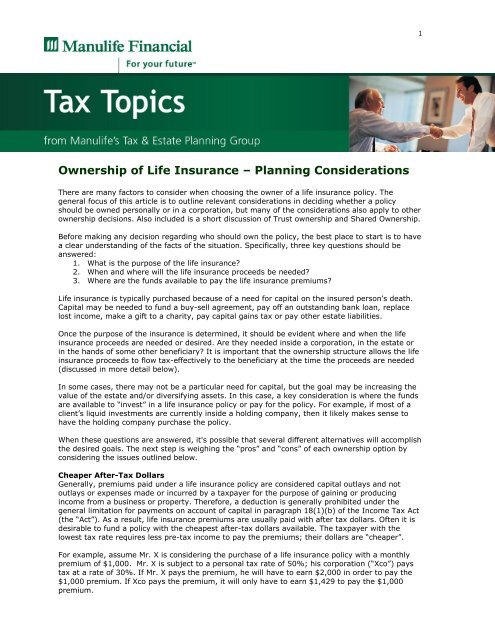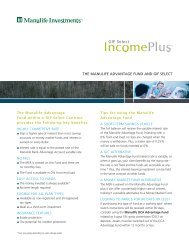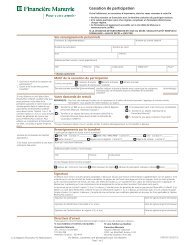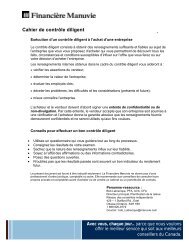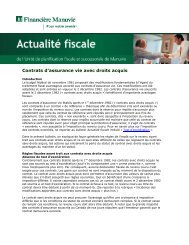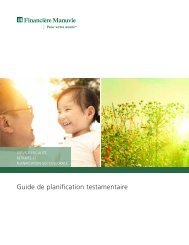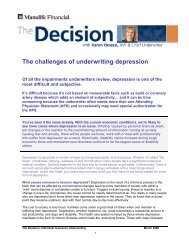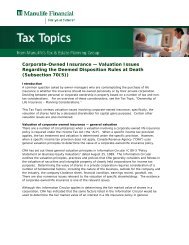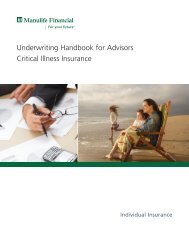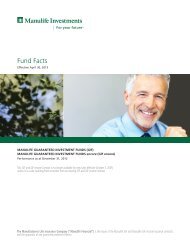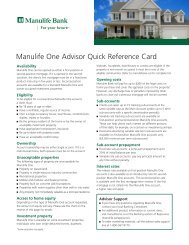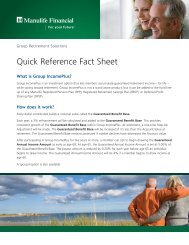Ownership of Life Insurance - Repsource - Manulife Financial
Ownership of Life Insurance - Repsource - Manulife Financial
Ownership of Life Insurance - Repsource - Manulife Financial
Create successful ePaper yourself
Turn your PDF publications into a flip-book with our unique Google optimized e-Paper software.
1<br />
<strong>Ownership</strong> <strong>of</strong> <strong>Life</strong> <strong>Insurance</strong> – Planning Considerations<br />
There are many factors to consider when choosing the owner <strong>of</strong> a life insurance policy. The<br />
general focus <strong>of</strong> this article is to outline relevant considerations in deciding whether a policy<br />
should be owned personally or in a corporation, but many <strong>of</strong> the considerations also apply to other<br />
ownership decisions. Also included is a short discussion <strong>of</strong> Trust ownership and Shared <strong>Ownership</strong>.<br />
Before making any decision regarding who should own the policy, the best place to start is to have<br />
a clear understanding <strong>of</strong> the facts <strong>of</strong> the situation. Specifically, three key questions should be<br />
answered:<br />
1. What is the purpose <strong>of</strong> the life insurance?<br />
2. When and where will the life insurance proceeds be needed?<br />
3. Where are the funds available to pay the life insurance premiums?<br />
<strong>Life</strong> insurance is typically purchased because <strong>of</strong> a need for capital on the insured person's death.<br />
Capital may be needed to fund a buy-sell agreement, pay <strong>of</strong>f an outstanding bank loan, replace<br />
lost income, make a gift to a charity, pay capital gains tax or pay other estate liabilities.<br />
Once the purpose <strong>of</strong> the insurance is determined, it should be evident where and when the life<br />
insurance proceeds are needed or desired. Are they needed inside a corporation, in the estate or<br />
in the hands <strong>of</strong> some other beneficiary? It is important that the ownership structure allows the life<br />
insurance proceeds to flow tax-effectively to the beneficiary at the time the proceeds are needed<br />
(discussed in more detail below).<br />
In some cases, there may not be a particular need for capital, but the goal may be increasing the<br />
value <strong>of</strong> the estate and/or diversifying assets. In this case, a key consideration is where the funds<br />
are available to “invest” in a life insurance policy or pay for the policy. For example, if most <strong>of</strong> a<br />
client’s liquid investments are currently inside a holding company, then it likely makes sense to<br />
have the holding company purchase the policy.<br />
When these questions are answered, it's possible that several different alternatives will accomplish<br />
the desired goals. The next step is weighing the “pros” and “cons” <strong>of</strong> each ownership option by<br />
considering the issues outlined below.<br />
Cheaper After-Tax Dollars<br />
Generally, premiums paid under a life insurance policy are considered capital outlays and not<br />
outlays or expenses made or incurred by a taxpayer for the purpose <strong>of</strong> gaining or producing<br />
income from a business or property. Therefore, a deduction is generally prohibited under the<br />
general limitation for payments on account <strong>of</strong> capital in paragraph 18(1)(b) <strong>of</strong> the Income Tax Act<br />
(the “Act”). As a result, life insurance premiums are usually paid with after tax dollars. Often it is<br />
desirable to fund a policy with the cheapest after-tax dollars available. The taxpayer with the<br />
lowest tax rate requires less pre-tax income to pay the premiums; their dollars are “cheaper”.<br />
For example, assume Mr. X is considering the purchase <strong>of</strong> a life insurance policy with a monthly<br />
premium <strong>of</strong> $1,000. Mr. X is subject to a personal tax rate <strong>of</strong> 50%; his corporation (“Xco”) pays<br />
tax at a rate <strong>of</strong> 30%. If Mr. X pays the premium, he will have to earn $2,000 in order to pay the<br />
$1,000 premium. If Xco pays the premium, it will only have to earn $1,429 to pay the $1,000<br />
premium.
2<br />
Although this is a convenient way to think about this issue, and the relative tax rates will tell you<br />
which owner is preferable from a cost perspective, it is not an accurate way <strong>of</strong> calculating the<br />
actual cost. A more accurate analysis reflects the after-tax cost <strong>of</strong> paying the premiums, rather<br />
than the pre-tax cost. Put another way, ideally the analysis should take into account the tax<br />
savings to a corporation, if any, when it flows money to Mr. X as demonstrated in the example<br />
below.<br />
Using the same facts outlined above, let’s assume Mr. X wants to fund the policy out <strong>of</strong> cash<br />
currently held inside Xco. Mr. X has a personal tax rate <strong>of</strong> 50% on salary and 30% on dividends.<br />
If Xco owns the policy and pays the premium directly, the after-tax cost to Xco is simply the<br />
premium amount, i.e., $1,000.<br />
If Mr. X wants to pay the premium and own the policy personally, then Xco must pay him enough<br />
so that he keeps $1,000 after-tax to pay the insurance premium. Xco has two options:<br />
1. Xco pays Mr. X a dividend <strong>of</strong> $1,429. Mr. X pays dividend tax <strong>of</strong> $429 ($1,429 x 30%)<br />
leaving $1,000 to pay the premium. This costs Xco $1,429 instead <strong>of</strong> just $1,000; or<br />
2. Xco pays Mr. X salary <strong>of</strong> $2,000. Mr. X pays $1,000 <strong>of</strong> tax on the salary ($2,000 x<br />
50%) leaving $1,000 to pay the premium. This costs Xco $1,400 ($2,000 less $600 in<br />
corporate tax savings generated by deducting $2,000 from its taxable income ($2,000<br />
x 30%)).<br />
To summarize, if the money to fund the premiums must come from Xco, there are three options:<br />
1. Xco owns the policy and pays the premium directly. Xco after-tax cost: $1,000;<br />
2. Xco pays a dividend to Mr. X; Mr. X pays the premium and owns the policy. Xco after<br />
tax cost: $1,429; and<br />
3. Xco pays salary to Mr. X; Mr. X pays the premium and owns the policy. Xco after tax<br />
cost: $1,400.<br />
The cheapest alternative is to simply have the corporation own and pay for the policy. Note<br />
however, that an inherent assumption in this analysis is that the premium payments must come<br />
from the corporation. If Mr. X has other personal funds from which he can pay the premiums and<br />
he does not expect to use these funds for personal expenditures during his lifetime, then it may<br />
not matter if he uses personal funds to pay the premiums since the tax has already been paid on<br />
these funds. In effect, the personal tax paid on the personal funds is a “sunk” cost; it has already<br />
been expended. As a result, it is no longer relevant to the decision about whether to use corporate<br />
dollars or personal dollars. In this case, the other considerations discussed below may have a<br />
more significant impact on where the policy should be held.<br />
Impact on Estate Value<br />
Although it is true to say that the tax paid on personal dollars is a “sunk” cost, consideration must<br />
also be given to the impact that future taxes will have on the individual’s estate value. There are<br />
two important characteristics <strong>of</strong> corporate owned life insurance that can reduce the taxes paid on<br />
the shares <strong>of</strong> a corporation at death and on the distribution <strong>of</strong> corporate assets. First, a life<br />
insurance death benefit received by a corporation may give rise to a capital dividend account<br />
(“CDA”) credit. Second, the value <strong>of</strong> a corporate owned life insurance policy, for purposes <strong>of</strong> the<br />
deemed disposition <strong>of</strong> the shares at death, is generally limited to the cash surrender value <strong>of</strong> the<br />
policy.<br />
When a Canadian Controlled Private Corporation (“CCPC”) receives a death benefit from an<br />
exempt life insurance policy, it receives a credit to its CDA equal to the excess <strong>of</strong> the proceeds<br />
over the corporation’s adjusted cost basis (“ACB”) <strong>of</strong> the policy immediately before death. To the<br />
extent that the corporation has a CDA balance, it can declare and pay capital dividends to<br />
Canadian resident shareholders. Capital dividends are not taxable to the shareholder; therefore,<br />
the proceeds from a life insurance death benefit in excess <strong>of</strong> the ACB <strong>of</strong> the policy can be<br />
distributed from a corporation tax- free. (Refer to the “Capital Dividend Account” Tax Topic for a<br />
more detailed discussion <strong>of</strong> the CDA and the ACB <strong>of</strong> a life insurance policy.)
3<br />
On death, all corporate shares owned by an individual are deemed to be disposed <strong>of</strong> at fair market<br />
value. For this purpose, the value <strong>of</strong> a corporate owned life insurance policy on a shareholder is<br />
generally deemed to be the cash surrender value (refer to the Tax Topic, “Corporate-Owned<br />
<strong>Insurance</strong> — Valuation Issues Regarding the Deemed Disposition Rules at Death (Subsection<br />
70(5))” for details). As a result, life insurance policies held in a corporation have the effect <strong>of</strong><br />
reducing the value <strong>of</strong> the corporation for purposes <strong>of</strong> the deemed disposition at death (if the<br />
shareholder owns common/participating shares). Through the CDA, the corporate dollars held in a<br />
life insurance policy can be sheltered from the personal tax that would otherwise arise at death<br />
and on the distribution <strong>of</strong> the corporation’s assets. Because <strong>of</strong> these potential benefits, life<br />
insurance can be an attractive “investment” for private corporations and may increase a person’s<br />
estate value more than a personally owned policy <strong>of</strong> the same size. In other words, while a policy<br />
may provide the same death benefit whether held in a corporation or personally, the corporately<br />
owned policy provides the additional benefit <strong>of</strong> potentially reducing the taxes payable on the<br />
shares <strong>of</strong> the corporation at death and on the distribution <strong>of</strong> the corporation’s assets to the estate<br />
(assuming that the shareholder/life insured owns all <strong>of</strong> the shares <strong>of</strong> the corporation). If the<br />
shareholder/insured owns only some <strong>of</strong> the shares <strong>of</strong> the corporation, particularly if the shares are<br />
fixed value shares, owning the policy corporately (or transferring a policy into a corporation) may<br />
not be beneficial from an estate value perspective. For a detailed discussion regarding life<br />
insurance as a corporate investment, refer to the Tax Topics, “Accumulating and Transferring<br />
Wealth Through the Use <strong>of</strong> <strong>Life</strong> <strong>Insurance</strong> – Corporate <strong>Ownership</strong>”.<br />
Corporate Owned <strong>Life</strong> <strong>Insurance</strong> to Fund Personal <strong>Insurance</strong> Needs<br />
Beneficiary Designation<br />
A key consideration is whether the intended beneficiary <strong>of</strong> the life insurance death benefit is an<br />
individual. Generally speaking, to avoid taxable benefit issues, a corporate owned policy should<br />
name the corporation as the beneficiary. As noted above, when a corporation receives the death<br />
benefit from a life insurance policy, it receives a credit to its CDA. To the extent <strong>of</strong> the CDA, it can<br />
flow the death benefit to a shareholder by paying a tax-free capital dividend. However, there is no<br />
such mechanism to get the proceeds out <strong>of</strong> the corporation to a person who is not a shareholder<br />
<strong>of</strong> the corporation. Therefore, if the life insurance proceeds are intended to benefit someone other<br />
than a shareholder or a particular shareholder (or his/her estate) for a specified purpose, some<br />
additional steps may be necessary.<br />
For example, if the policy is on the life <strong>of</strong> the sole shareholder <strong>of</strong> the corporation, the life insurance<br />
proceeds could be paid as a dividend to the estate <strong>of</strong> the shareholder after his/her death. The<br />
dividend will be non-taxable to the estate to the extent <strong>of</strong> the CDA balance. The estate then pays<br />
the proceeds to the beneficiary as outlined in the deceased shareholder’s Will. However, the<br />
proceeds will flow through the estate possibly subjecting the proceeds to probate and potential<br />
claims <strong>of</strong> the estate’s creditors.<br />
Documenting the Intentions <strong>of</strong> the Shareholder<br />
Consideration should be given as to how the intentions <strong>of</strong> the sole shareholder are documented.<br />
The Will can provide direction and appropriate powers to the executor and enable the executor to<br />
direct the corporation to pay the life insurance proceeds out <strong>of</strong> the corporation as a dividend. The<br />
Will can also communicate the extent to which the CDA is intended to be utilized.<br />
However, there may be a conflict between the executor’s role and responsibility as executor <strong>of</strong> the<br />
estate and the executor’s role and responsibility as director <strong>of</strong> the corporation. The executor’s role<br />
as executor <strong>of</strong> the estate requires him/her to act in the best interests <strong>of</strong> the estate beneficiaries<br />
while the executor’s role as director <strong>of</strong> the corporation requires him/her to act in the best interest<br />
<strong>of</strong> the corporation. The decision that the executor makes regarding the payment <strong>of</strong> dividends and<br />
use <strong>of</strong> the CDA may not necessarily be the one that he/she would make in his/her capacity as an<br />
<strong>of</strong>ficer <strong>of</strong> the corporation. This conflict may be easier to understand in a situation where the<br />
majority shareholder does not own all the shares. For example, there may be a group <strong>of</strong><br />
employees that own 35% <strong>of</strong> the voting shares. In this case, the executor, acting as an <strong>of</strong>ficer <strong>of</strong><br />
the corporation, has a duty to the minority shareholders to ensure they are treated fairly. That is,<br />
if he/she allocates all <strong>of</strong> the CDA to the majority shareholder, he/she is not acting in the best<br />
interests <strong>of</strong> all the shareholders. Clear direction in a shareholder’s agreement would relieve the<br />
executor <strong>of</strong> this potential conflict because it would obligate the corporation or the shareholder’s<br />
executor to carry out the intended distribution <strong>of</strong> life insurance and CDA to the estate <strong>of</strong> the<br />
deceased shareholder. Alternatively, as discussed below, life insurance shares might be used to<br />
alleviate this conflict.
<strong>Life</strong> <strong>Insurance</strong> Shares<br />
In some cases, “life insurance shares” may be used to direct insurance proceeds to a specific<br />
individual. <strong>Life</strong> insurance shares are shares that entitle the holder to the death benefit proceeds<br />
from a corporate owned life insurance policy, but otherwise have no control or value. Typically,<br />
shares are created that are non-voting, non-participating, redeemable for $1 at the discretion <strong>of</strong><br />
the corporation, and entitling the holder to receive a dividend equal to the proceeds <strong>of</strong> the life<br />
insurance received by the corporation when the life insured dies. (The dividend could be paid as a<br />
non-taxable capital dividend to the extent <strong>of</strong> the CDA credit arising from the life insurance policy.)<br />
The intended beneficiary might purchase such shares for $1, usually prior to issuing the policy.<br />
The main tax issue with such shares is whether the $1 purchase price represents a reasonable<br />
value for the shares. If not, (i.e., if the shares are worth more than what the purchaser pays for<br />
them), then a taxable benefit may arise to either the common shareholder or the purchaser (refer<br />
to CRA technical interpretations 2005-013861C6 and 2008-028615C6 for CRA’s views on valuation<br />
issues related to life insurance shares).<br />
<strong>Life</strong> insurance shares issued to the sole shareholder can also be used to resolve the conflict <strong>of</strong><br />
interest issue noted above with respect to the executor’s role as director <strong>of</strong> the corporation and as<br />
executor <strong>of</strong> the estate <strong>of</strong> the deceased shareholder. If the intention is for the shareholder’s estate<br />
to benefit from the life insurance proceeds, life insurance shares can be issued to the shareholder<br />
before purchasing the policy. When the shareholder dies, these shares enable the executor to<br />
force redemption <strong>of</strong> the shares and utilize the CDA to shelter the dividend as a right created by<br />
the attributes <strong>of</strong> the shares. Because the executor, as a director <strong>of</strong> the corporation, does not need<br />
to cause the corporation to redeem the shares and use the CDA balance, the conflict is avoided.<br />
<strong>Financial</strong> Statement Impact <strong>of</strong> Corporate Owned <strong>Life</strong> <strong>Insurance</strong><br />
When a life insurance policy is owned by a corporation, it is an asset <strong>of</strong> that corporation and may<br />
have an impact on the corporation’s financial statements.<br />
For accounting purposes, typically a corporation will record a life insurance policy as an asset on<br />
its balance sheet at a value equal to the cash surrender value the policy. Each year, the difference<br />
between the premiums paid in the year and the increase in the cash value is recorded as income<br />
or expense for the year. When the death benefit is received, the asset (if one exists) is eliminated<br />
and the difference between the death benefit and the asset is recorded as accounting income.<br />
If a policy is heavily funded in the early years, the increase in the cash surrender value will usually<br />
be less than the premiums paid; therefore, an expense will be recorded. This decreases the<br />
accounting value <strong>of</strong> the company’s assets on the balance sheet. Consideration should be given to<br />
the impact this might have on any debt covenants or shareholder agreements that the corporation<br />
is subject to.<br />
For more information on accounting for life insurance, refer to the Tax Topic, “Accounting for<br />
Corporate Owned <strong>Life</strong> <strong>Insurance</strong> and Critical Illness <strong>Insurance</strong>”.<br />
<strong>Life</strong> <strong>Insurance</strong> as a Corporate Asset – Valuation and Tax Considerations<br />
A corporate owned life insurance policy affects the fair market value <strong>of</strong> the shares <strong>of</strong> the<br />
corporation. For example, if a corporation that owns a life insurance policy is sold, the value that a<br />
buyer is willing to pay will include the “value” <strong>of</strong> the policy owned by the corporation, as<br />
determined by the buyer.<br />
Similarly, for many tax provisions it is necessary to take into account the value <strong>of</strong> a corporate<br />
owned life insurance policy. When a specific income tax provision applies, the tax treatment and<br />
valuation is determined under the specific provision. However, when a specific income tax<br />
provision does not apply, CRA uses general valuation principles, as set out in Information Circular<br />
IC 89-3 “Policy Statement on Business Equity Valuations” dated August 25, 1989, to determine<br />
the value <strong>of</strong> a corporate-owned life insurance policy. CRA considers such factors, among others,<br />
as the cash value and death benefit <strong>of</strong> the policy, the terms <strong>of</strong> the policy such as riders and<br />
conversion privileges and the health <strong>of</strong> the life insured.<br />
One <strong>of</strong> the income tax provisions that specifically provides for the valuation <strong>of</strong> a corporate owned<br />
life insurance policy is subsection 70(5.3) <strong>of</strong> the Act. This provision deems the value <strong>of</strong> a corporate<br />
owned (or partnership owned) life insurance policy on the life <strong>of</strong> the taxpayer to equal the cash<br />
surrender value <strong>of</strong> the policy for purposes <strong>of</strong> the deemed disposition <strong>of</strong> the shares (or partnership<br />
4
interest) on the death <strong>of</strong> the taxpayer under subsections 70(5) and 104(4) <strong>of</strong> the Act, and for<br />
purposes <strong>of</strong> the deemed disposition upon becoming or ceasing to be a resident <strong>of</strong> Canada under<br />
section 128.1 <strong>of</strong> the Act. Note however, that if a value is determined under a shareholder’s<br />
agreement in respect <strong>of</strong> shares belonging to a deceased taxpayer, that agreement will generally<br />
be determinative <strong>of</strong> value if the conditions outlined in Information Circular IC 89-3 are met. (For<br />
more detail, refer to the Tax Topic, “Corporate-Owned <strong>Insurance</strong> — Valuation Issues Regarding<br />
the Deemed Disposition Rules at Death (Subsection 70(5))”).<br />
In addition, a life insurance policy is generally considered a “passive” asset. As such, the value <strong>of</strong><br />
the policy can affect whether the shares <strong>of</strong> the company qualify for the lifetime capital gains<br />
exemption, whether the shares qualify for the rollover <strong>of</strong> family farm and fishing corporations or<br />
whether the corporate attribution rule in subsection 74.4(2) <strong>of</strong> the Act could apply to the shares.<br />
(For further details, refer to the Tax Topic entitled, “The <strong>Life</strong>time Capital Gains Exemption).<br />
For the purposes <strong>of</strong> determining whether the corporation’s shares, on a disposition, qualify for the<br />
lifetime capital gains exemption or whether the shares qualify for the rollover <strong>of</strong> family farm and<br />
fishing corporations, it is necessary to determine the proportion <strong>of</strong> the corporation’s underlying<br />
assets used in an active business. Owning a passive asset, such as a life insurance policy, may<br />
affect whether or not the shares are considered qualified shares. For these purposes, the policy<br />
will generally be valued at its cash surrender value under subparagraph 110.6(15)(a)(i) or (ii) <strong>of</strong><br />
the Act, provided the shareholder is the life insured.<br />
The corporate attribution rule in subsection 74.4(2) <strong>of</strong> the Act will not apply if the corporation<br />
qualifies as a “small business corporation” as defined in subsection 248(1) <strong>of</strong> the Act. This<br />
definition requires (among other things) that “all or substantially all” <strong>of</strong> the assets <strong>of</strong> the<br />
corporation are used principally in an active business. Owning a passive asset like a life insurance<br />
policy may cause a corporation to fail this test. For this purpose, the life insurance policy is valued<br />
at fair market value using general valuation principles. (For more detail on the corporate<br />
attribution rules, refer to the “Corporate Owned <strong>Life</strong> <strong>Insurance</strong> – Tax Considerations” Tax Topic.)<br />
The small business deduction entitles CCPCs to a tax reduction on the first $500,000 <strong>of</strong> active<br />
business income carried on in Canada (for details on these rules, refer to the “Corporate Taxation”<br />
Tax Topic). However, the deduction is phased out where the corporation’s “taxable capital” for the<br />
immediately preceding year exceeds $10 million and is eliminated when the corporation’s taxable<br />
capital exceeds $15 million. Taxable capital for this purpose is a complex calculation, but generally<br />
includes the capital, retained earnings and debt <strong>of</strong> the corporation less an investment allowance.<br />
Since a life insurance policy does not qualify as an eligible investment for purposes <strong>of</strong> the<br />
investment allowance (see CRA technical interpretation 2003-0049531I7), to the extent that a life<br />
insurance policy increases the capital <strong>of</strong> a corporation, it may affect whether the corporation is<br />
entitled to the small business deduction. For example, if the growth in the cash value is<br />
recognized as income and therefore increases retained earnings (refer to the Tax Topic,<br />
“Corporate Owned <strong>Life</strong> <strong>Insurance</strong> – Tax Considerations”).<br />
5<br />
Future Changes in Share <strong>Ownership</strong><br />
If corporate ownership is contemplated, consideration should be given as to whether the shares <strong>of</strong><br />
the corporation may be sold in the future. If selling the shares is a possibility and it is likely that<br />
the current shareholder will want to keep the policy, it may not be advisable to hold the policy in<br />
the corporation. The policy could be transferred to another company prior to a sale, but transfers<br />
trigger a disposition <strong>of</strong> the policy. Since there are no rollovers available for transferring policies<br />
between corporations or between corporations and individuals, any transfer to a related party will<br />
trigger a policy gain to the extent that the cash surrender value exceeds the ACB <strong>of</strong> the policy. In<br />
addition, consideration must be given as to how the recipient <strong>of</strong> the policy will be taxed on the<br />
transfer. If the consideration paid for the policy is less than the fair market value <strong>of</strong> the policy, the<br />
recipient <strong>of</strong> the policy may have a taxable benefit. Where the policy is transferred as a dividend in<br />
kind to a connected corporation, there may not be a taxable benefit (dividends paid to a<br />
connected corporation are generally not subject to income tax). However, if the policy is<br />
transferred as a non-taxable dividend in kind, in anticipation <strong>of</strong> a sale, subsection 55(2) <strong>of</strong> the Act<br />
may apply to deem the tax-free, inter-corporate dividend to be a taxable capital gain. Refer to the<br />
Tax Topic, “Transfer <strong>of</strong> an <strong>Insurance</strong> Policy Involving Corporations and a Shareholder or<br />
Employee” for a more complete discussion <strong>of</strong> transfers.
6<br />
Corporate Groups<br />
In some cases, there may be several corporations owned by the client/life insured, including<br />
operating companies, holding companies that own shares <strong>of</strong> operating companies, and investment<br />
companies that hold marketable securities or other investments. Since operating companies are<br />
<strong>of</strong>ten more likely to be sold and may have more exposure to creditors, it is <strong>of</strong>ten preferable to<br />
place insurance policies in holding companies or investment companies. However, if the death<br />
benefit is needed in the operating company, consideration should be given as to how the funds<br />
can be transferred or directed to the operating company at the time <strong>of</strong> death. One option would be<br />
to designate the operating company as beneficiary with the parent holding company as owner <strong>of</strong><br />
the policy. In this case, the operating company will receive the full CDA credit equal to the full<br />
amount <strong>of</strong> the death benefit. This is because the CDA credit is reduced by the policy owner’s ACB<br />
<strong>of</strong> the policy. Since the holding company (not the operating company) owns the policy, the ACB<br />
belongs to the holding company; the operating company has a nil ACB in the policy. However, CRA<br />
has provided commentary that taxable benefit issues may arise in such structures and that GAAR<br />
could apply when considering the CDA credit to Opco (for example, refer to CRA technical<br />
interpretation letters 9824645, 9908430, 2004-0065461C6, 2007-0127251E5, 2010-0359421C6<br />
and Question 1 from the 2010 APFF CRA Roundtable).<br />
As a result, it is <strong>of</strong>ten preferable to have the corporate owner paying the premiums and being the<br />
beneficiary <strong>of</strong> the policy. Most structures in which one corporation owns a life insurance policy and<br />
another corporation either pays the premiums or is designated as beneficiary give rise to potential<br />
tax issues. If it is desirable for one corporation to own the policy, but the death benefit proceeds<br />
are needed in another corporation within the corporate group, it should be possible to transfer the<br />
proceeds as a capital injection, an inter-corporate loan or a dividend in kind rather than using a<br />
beneficiary designation. (For a more extensive discussion <strong>of</strong> the tax issues related to ownership<br />
and beneficiary designations in the corporate context, refer to the Tax Topic, “Corporate Owned<br />
<strong>Life</strong> <strong>Insurance</strong> – Tax Considerations”.)<br />
Creditor Protection Issues<br />
Personal ownership <strong>of</strong> a policy can provide greater opportunities to protect the life insurance policy<br />
from creditors, both during life and after death, through appropriate beneficiary designations. In<br />
contrast, corporately owned policies are generally exposed to the corporation’s creditors.<br />
For a personally owned policy, creditor protection during the life <strong>of</strong> the insured can be achieved in<br />
two ways: by making an irrevocable beneficiary designation in respect <strong>of</strong> a life insurance policy or<br />
by designating, as beneficiaries, certain family members specified in provincial insurance<br />
legislation. (This can protect the policy itself and any cash value <strong>of</strong> the policy from creditors <strong>of</strong> the<br />
owner, subject to certain limitations). Since a corporation does not have “family members”, this<br />
method <strong>of</strong> creditor protection is not available to corporations. Using an irrevocable beneficiary<br />
designation for a corporate owned policy may not be practical due to the taxable benefit issues<br />
that arise when a corporation designates another person or corporation as beneficiary <strong>of</strong> a policy it<br />
owns. An irrevocable beneficiary designation made by a corporation should, at least in theory,<br />
provide the same type <strong>of</strong> creditor protection as it does for a personally owned policy.<br />
Creditors <strong>of</strong> the policy owner cannot make a claim against the proceeds <strong>of</strong> a policy that are<br />
payable upon the death <strong>of</strong> the life insured if the policy owner designates a beneficiary. When a<br />
beneficiary designation is made to a third party, the insurance proceeds payable upon the death <strong>of</strong><br />
the life insured belong to the beneficiary and do not belong to the policy owner or the estate <strong>of</strong> the<br />
owner (in the case <strong>of</strong> an individually owned policy). <strong>Insurance</strong> proceeds are not subject to the<br />
claims <strong>of</strong> the owner’s creditors. Subject to certain limitations, the insurance death benefit would<br />
be protected if a corporate owner designates another person (including another corporation) as<br />
beneficiary, but again, this may not be practical due to the taxable benefit issues discussed<br />
earlier.<br />
In most provinces, insurance proceeds are generally excluded from matrimonial property division<br />
if the proceeds are received personally. However, if a corporation receives the proceeds and then<br />
distributes them to the shareholder, the proceeds are not excluded. The treatment <strong>of</strong> insurance<br />
proceeds for the purposes <strong>of</strong> matrimonial property may be an important consideration especially<br />
where the beneficiary <strong>of</strong> a corporately owned policy may be the owner <strong>of</strong> the corporation (or a<br />
related company) and may influence whether the insurance is held personally or in the<br />
corporation. In addition, the policy is an asset to the owner (individual or corporate); this may<br />
affect valuations used for family law purposes in some provinces.
For more information on creditor protection and life insurance, refer to the Tax Topics, “Creditor<br />
Protection and <strong>Life</strong> <strong>Insurance</strong>”, “Limitations on Creditor Protection and <strong>Life</strong> <strong>Insurance</strong>” and “<strong>Life</strong><br />
<strong>Insurance</strong> and Property Issues on Marriage Breakdown”.<br />
7<br />
Accessing Policy Values<br />
A common planning strategy is depositing funds into a life insurance policy in excess <strong>of</strong> what is<br />
needed to pay for the death benefit. This strategy accumulates cash value in the policy that may<br />
be accessed in the future. The owner can access the cash values by assigning the policy as<br />
collateral security for a loan, utilizing policy loans (if permitted under the policy terms) or making<br />
policy withdrawals. If accessing the policy value is contemplated, the owner should consider where<br />
these funds will be needed and how they will flow to the right person.<br />
For example, if a policy is held in the corporation but there is a desire to access the policy values<br />
personally, then withdrawals would need to flow out to the shareholder as salary or dividends.<br />
Similarly, if the policy is assigned as a collateral loan, there may be tax implications where the<br />
individual or the corporation is the borrower. For example, if a corporately owned policy is<br />
assigned as collateral security for a personal loan, consideration must be given to the possibility<br />
that a shareholder benefit has been conferred under subsection 15(1) <strong>of</strong> the Act. Alternatively, if<br />
the corporation is the borrower, the loan proceeds must flow to the shareholder as salary or<br />
dividends. Caution must also be used in these situations to ensure that the policy is not deemed to<br />
be a Retirement Compensation Arrangement causing the premiums paid on the policy to become<br />
subject to a 50% refundable tax. (For a discussion <strong>of</strong> the issues associated with leveraged life<br />
insurance, refer to the Tax Topics, “Leveraged <strong>Life</strong> <strong>Insurance</strong> (Corporate and Personal)”.)<br />
Future Changes in Residency<br />
Individuals leaving Canada are deemed to dispose <strong>of</strong> most assets, including shares in a private<br />
corporation. A personally owned life insurance policy is excluded from the deemed disposition<br />
rules. However, the fair market value <strong>of</strong> shares in a private corporation will include the cash<br />
surrender value <strong>of</strong> corporate owned insurance. Consequently, when the shareholder leaves<br />
Canada, the capital gains tax will be higher, reflecting the corporation’s ownership <strong>of</strong> a cash value<br />
life insurance policy. Therefore, personal ownership on emigration from Canada, avoids triggering<br />
a gain equal to the cash value. (Note that a policy owned by a non-resident will be subject to<br />
withholding tax on any policy gains arising on dispositions such as policy loans and withdrawals.<br />
For more details, refer to the Tax Topic, “Emigration from Canada: Tax Implications”).<br />
The income tax treatment <strong>of</strong> the policy and the death benefit in the new country <strong>of</strong> residence<br />
should also be considered. Canada allows for a certain amount <strong>of</strong> value to accumulate in an<br />
exempt life insurance policy without being subject to Canadian income tax. When a person<br />
immigrates to a new country, they, and the life insurance policy they own, will be subject to the<br />
income tax rules in that country. For example, the accumulation <strong>of</strong> funds within the life insurance<br />
policy may be subject to tax, or at a minimum, the rules governing how much accumulation is<br />
allowed will be different from the rules in Canada. Similarly life insurance death benefits are<br />
received tax-free in Canada, but this may not be the case in all jurisdictions. If a departure is<br />
planned, these rules will be important if the policy is owned personally. However, if a corporation<br />
whose shareholder is leaving Canada owns the policy and the corporation remains resident in<br />
Canada, the policy will continue to be taxed under Canadian income tax rules, thus avoiding this<br />
issue.<br />
If the policy is corporate owned, consideration must be given as to how the life insurance proceeds<br />
will flow out <strong>of</strong> the corporation. To receive a CDA credit, a corporation must be a Canadian<br />
resident corporation, but does not need to be Canadian controlled. Therefore, a Canadian resident<br />
corporation owned by a non-resident shareholder could receive a CDA credit on receipt <strong>of</strong> a life<br />
insurance death benefit. However, it is unlikely that a capital dividend paid to a non-resident will<br />
receive the same tax-free treatment in the shareholder’s new country <strong>of</strong> residence as it would in<br />
Canada. Additionally, the capital dividend will be subject to Canadian withholding tax (refer to<br />
technical interpretation 2009-0327001C6). As a result, unless the corporation has other Canadian<br />
resident shareholders, there may be no tax efficient mechanism to extract life insurance proceeds<br />
from the corporation. This may suggest that it is preferable to own a policy personally if the<br />
shareholder is leaving Canada, unless the proceeds are intended to go to Canadian resident<br />
shareholders or remain inside the corporation.
8<br />
US Estate Tax<br />
If a person is a U.S. person (i.e., citizen, green card holder or resident <strong>of</strong> the United States), they<br />
are subject to US estate tax. <strong>Life</strong> insurance proceeds are included in the value <strong>of</strong> an individual’s<br />
estate for U.S. estate tax purposes if the individual has any “incidence <strong>of</strong> ownership” in the policy.<br />
Therefore, the death benefit <strong>of</strong> a personally owned life insurance policy on the life <strong>of</strong> the owner will<br />
be included in their estate. Similarly, if the U.S. person owns all the shares <strong>of</strong> a corporation that<br />
owns a life insurance policy on their life, the death benefit <strong>of</strong> the policy will be included in the<br />
value <strong>of</strong> the shares for U.S. estate tax purposes. In these circumstances, it is common to hold the<br />
policy through a special trust called an Irrevocable <strong>Life</strong> <strong>Insurance</strong> Trust (“ILIT”) that can be<br />
structured to avoid inclusion <strong>of</strong> the death benefit in the estate <strong>of</strong> the life insured. For more details,<br />
refer to the Tax Topic, “U.S. Estate Taxes”.<br />
Buy-Sell Funding<br />
When insurance is used to fund the buy-out <strong>of</strong> a shareholder at death, there are several structures<br />
that can be used. Some involve personally held insurance (such as the criss-cross method) and<br />
some involve corporately owned insurance (such as the promissory note method or redemption<br />
method). The decision as to which buy-sell method should be used will include all the ownership<br />
considerations discussed above, as well as some additional considerations.<br />
One consideration is the tax result where the insurance is owned by the shareholders versus the<br />
corporation. If personally owned insurance is used to fund a buy-sell agreement (using the crisscross<br />
method), the surviving shareholders will have an increased adjusted cost base <strong>of</strong> their<br />
shares and the deceased will receive capital gains treatment. If corporate-owned insurance is used<br />
to fund the buy-sell agreement, the promissory note method, the redemption method or some<br />
combination <strong>of</strong> the two can be used to accomplish the buy-sell. The promissory note method has<br />
the same tax consequences as the criss-cross method. If the shares <strong>of</strong> the corporation are<br />
redeemed, the survivors have an increased ownership in the company but their adjusted cost base<br />
does not change. The deceased’s estate will receive dividend treatment on the redemption<br />
proceeds and some or all <strong>of</strong> the dividend may be characterized as a tax-free capital dividend.<br />
Personally-owned insurance to fund a buy-sell agreement can get complicated where there are<br />
more than two shareholders involved. Multiple policies on the same life insured will be necessary;<br />
it may be difficult to track and determine whether the premiums have been paid on all the policies<br />
to keep them in force. With corporate-owned insurance, only one policy is necessary for each<br />
shareholder; therefore, administration is easier.<br />
Differences in age, sex or health <strong>of</strong> the shareholders can result in significant differences between<br />
the premiums on each insurance policy. If the policies are owned personally, this may result in a<br />
disproportionate cost allocation. If the policies are owned corporately, the premiums are<br />
effectively allocated based on percentage ownership <strong>of</strong> the company.<br />
In the past, one <strong>of</strong> the most important reasons for using corporate ownership for buy-sell funding<br />
was the ability to defer capital gains tax by redeeming shares with life insurance during the first<br />
year <strong>of</strong> the estate. The stop-loss rules introduced in 1995 and contained in subsection 112(3) <strong>of</strong><br />
the Act, reduce the benefits <strong>of</strong> this type <strong>of</strong> planning for shares that are not grandfathered.<br />
Planning around these rules has become quite complex and a complete analysis <strong>of</strong> the impact <strong>of</strong><br />
the stop-loss rules is required to determine whether corporate or personal ownership is preferable.<br />
For a complete discussion <strong>of</strong> utilizing insurance for shareholder buy-outs at death, refer to the Tax<br />
Topics, “Buy/Sell Agreements – An Overview <strong>of</strong> Funding with <strong>Life</strong> <strong>Insurance</strong>", “Buy/Sell<br />
Agreements – Corporate Redemption Method”, “Buy/Sell Agreements – Criss-Cross Purchase<br />
Method”, “Buy/Sell Agreements – Hybrid Method”, and “Buy/Sell Agreements – Promissory Note<br />
Method”. For a discussion <strong>of</strong> the stop-loss rules, refer to the Tax Topic, “Stop-Loss Provisions and<br />
Grandfathering Rules”.<br />
Considerations for Transfers <strong>of</strong> Existing Policies<br />
Most <strong>of</strong> the issues raised so far will be also applicable in considering whether a life insurance policy<br />
should be transferred into or out <strong>of</strong> a corporation. However, it will also be important to consider<br />
the potential tax implications <strong>of</strong> the transfer itself. A transfer will always trigger a disposition <strong>of</strong><br />
the policy and therefore may give rise to a policy gain if the proceeds exceed the ACB <strong>of</strong> the<br />
policy. If it is a non-arm’s length transfer, a transfer for no consideration or a distribution from a
9<br />
corporation, the proceeds will be deemed under subsection 148(7) <strong>of</strong> the Act to equal the CSV <strong>of</strong><br />
the policy.<br />
The second aspect <strong>of</strong> any transfer is to consider whether any taxable benefit has been conferred<br />
as a result <strong>of</strong> the transfer. For transfers out <strong>of</strong> a corporation to a shareholder, employee or other<br />
related party, if the transferee does not pay fair market value for the policy, <strong>of</strong>ten the transferee<br />
will be considered to receive a taxable benefit. When a policy is transferred into a corporation, the<br />
corporation would generally want to pay fair market value consideration for the policy. If it pays<br />
more than fair market value, a taxable benefit could arise in the hands <strong>of</strong> the transferor. Refer to<br />
the Tax Topic, “Transfer <strong>of</strong> an <strong>Insurance</strong> Policy Involving Corporations and a Shareholder or<br />
Employee” for a more complete discussion <strong>of</strong> transfers.<br />
Trust <strong>Ownership</strong><br />
Sometimes the solution to an ownership problem is to have a trust own the life insurance policy. A<br />
trust allows control over the policy by the trustees, and when desirable, allows discretion over the<br />
distribution <strong>of</strong> the policy or insurance proceeds.<br />
A trust can sometimes be used to simplify administration where multiple policies would otherwise<br />
be required. For example, as noted earlier, in a life insured criss-cross buy sell arrangement,<br />
every shareholder must acquire a policy on every other shareholder to provide each shareholder<br />
with the funds to buy the shares <strong>of</strong> the deceased shareholder. Alternatively, a trust can be used to<br />
hold just one policy on every shareholder and also provide a mechanism to ensure that all the<br />
policies are kept in force (for more details, refer to the Tax Topics, “Buy/Sell Agreements – Criss-<br />
Cross Purchase Method” (with trustee & without trustee)).<br />
Another situation where trust ownership makes sense is when the policy will be owned by<br />
someone other than the life insured and the preferred successor owner <strong>of</strong> the policy is someone to<br />
whom a transfer would result in a policy gain or who is a minor. For example, consider the<br />
situation where Mom (a single parent) purchases a life insurance policy on the life <strong>of</strong> her minor<br />
child, with the intent <strong>of</strong> over-funding it and passing it on to the child when they reach age <strong>of</strong><br />
majority. If Mom names her sister or brother to be successor owner <strong>of</strong> the policy (in case she<br />
passes away before the child reaches the age <strong>of</strong> majority), a transfer at the time <strong>of</strong> her death<br />
would create a policy gain to the extent the cash surrender value exceeds the ACB at the time. It<br />
would also be undesirable to name the child as successor owner (even though there would be a<br />
tax-free rollover to the child under subsection 148(8)) because a minor child cannot legally deal<br />
with the policy and may not be old enough for the responsibility. A solution is to place the policy in<br />
a trust with the child as beneficiary <strong>of</strong> the trust. In this way, there is no disposition on the death <strong>of</strong><br />
Mom; the policy, policy withdrawals or death benefit can be distributed to the child as seen fit by<br />
the trustee(s).<br />
Trust ownership also makes sense when there is a life insurance need in the trust or by the<br />
beneficiaries. For example, a trust may hold life insurance to fund the capital gains tax arising on<br />
the deemed disposition <strong>of</strong> capital property held by a spousal trust on the death <strong>of</strong> the spouse.<br />
There has been much CRA commentary on the effectiveness <strong>of</strong> this type <strong>of</strong> structure. For a more<br />
detailed discussion <strong>of</strong> the commentary, please see the Tax Topic entitled, “Trusts as a Planning<br />
Tool”. Another example may be to fund the tax liability arising to the beneficiaries on growth<br />
shares that the trust acquired as a result <strong>of</strong> an estate freeze. A trust may also hold a life insurance<br />
policy as an alternative to other investments or for U.S. estate tax planning reasons, as mentioned<br />
earlier.<br />
Shared <strong>Ownership</strong> – Split Dollar <strong>Life</strong> <strong>Insurance</strong><br />
It is possible for two parties (corporate or personal) to agree to share the benefits associated with<br />
a life insurance policy and to split the premium costs. To avoid taxable benefit issues, each party<br />
should pay a reasonable amount for the benefit they receive. It is also generally advisable to have<br />
a written agreement detailing how the premiums and benefits will be allocated to each party. A<br />
policy can be split in virtually any way, as long as it is possible to determine a reasonable<br />
allocation <strong>of</strong> premiums and benefits. Commonly, a universal life policy with a face plus death<br />
benefit is used with one party funding and entitled to the cash value <strong>of</strong> the policy and another<br />
party funding and entitled to the death benefit <strong>of</strong> the policy. In the context <strong>of</strong> personal and<br />
corporate ownership, a common arrangement is having an operating company entitled to the<br />
death benefit portion <strong>of</strong> the policy and an individual or holding company entitled to the cash value.
This structure can be useful in solving many <strong>of</strong> the issues discussed earlier, including:<br />
creditor protection issues;<br />
issues with cash value life insurance as a corporate asset <strong>of</strong> an operating company;<br />
and<br />
a potential sale <strong>of</strong> an operating company.<br />
For a complete discussion <strong>of</strong> split dollar arrangements and their application, refer to the Tax<br />
Topics, “Split Dollar <strong>Life</strong> <strong>Insurance</strong>” and “Split Dollar <strong>Life</strong> <strong>Insurance</strong> – Applications”.<br />
10<br />
Conclusion<br />
<strong>Life</strong> insurance policies can be held personally, in a corporation or in a trust, or in more than one <strong>of</strong><br />
these entities jointly. There are many things to consider in determining what the best ownership<br />
structure is in any particular situation. Sometimes the answer will be obvious, but in other cases,<br />
the pros and cons <strong>of</strong> all <strong>of</strong> the issues raised in this Tax Topic will need to be weighed. It is<br />
important to keep in mind the objectives the life insurance is intended to fulfill, who is supposed to<br />
benefit from the proceeds and where the funds are available to fund the policy.<br />
Last Updated: November 2013<br />
The Tax & Estate Planning Group at <strong>Manulife</strong> <strong>Financial</strong> writes various publications on an ongoing<br />
basis. This team <strong>of</strong> accountants, lawyers and insurance pr<strong>of</strong>essionals provides specialized<br />
information about legal issues, accounting and life insurance and their link to complex tax and<br />
estate planning solutions.<br />
These publications are distributed on the understanding that <strong>Manulife</strong> <strong>Financial</strong> is not engaged in<br />
rendering legal, accounting or other pr<strong>of</strong>essional advice. If legal or other expert assistance is<br />
required, the service <strong>of</strong> a competent pr<strong>of</strong>essional should be sought.<br />
This information is for Advisor use only. It is not intended for clients. This document is protected<br />
by copyright. Reproduction is prohibited without <strong>Manulife</strong>'s written permission.<br />
strong reliable trustworthy forward-thinking<br />
<strong>Manulife</strong>, <strong>Manulife</strong> <strong>Financial</strong>, the <strong>Manulife</strong> <strong>Financial</strong> For Your Future logo, the Block Design, the Four Cubes Design, and Strong Reliable<br />
Trustworthy Forward-thinking are trademarks <strong>of</strong> The Manufacturers <strong>Life</strong> <strong>Insurance</strong> Company and are used by it, and by its affiliates under<br />
license.


